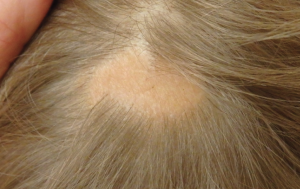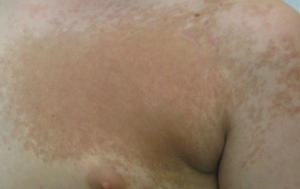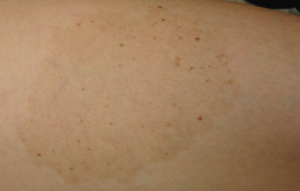Chapter 8: Lumps and Bumps
Other Birthmarks
Nevus Sebaceus
Nevus sebaceous are common congenital lesions that mainly occur on the face and scalp. It appears as hairless, yellow or tan plaques with a verrucous or rough surface. They are usually present at birth and grow proportionately with the child until puberty when they may become much thicker and more verrucous. Nevus sebaceous generally does not require treatment but if the patient is bothered by the appearance or the lesion develops a localized growth within it, surgical excision is recommended.

Epidermal Nevus
Epidermal nevi are benign congenital lesions that arise from hyperplasia (overgrowth) of the epidermis and superficial dermis. They present as tan to brown, velvety to verrucous papules or plaques. They are most commonly a single linear lesion that follows the lines of Blashko. Treatment of epidermal nevi is for cosmetic reasons and can be challenging. Complete surgical excision is effective but should be reserved for small, localized lesions. Superficial destructive therapies, such as cryotherapy, laser or electrodessication, are commonly followed by recurrence, but are helpful to debulk larger lesions. Epidermal nevus syndrome is the association of large or widespread epidermal nevi with non-skin changes.
Epidermal Nevus
Epidermal nevi are benign congenital lesions that arise from hyperplasia (overgrowth) of the epidermis and superficial dermis. They present as tan to brown, velvety to verrucous papules or plaques. They are most commonly a single linear lesion that follows the lines of Blashko. Treatment of epidermal nevi is for cosmetic reasons and can be challenging. Complete surgical excision is effective but should be reserved for small, localized lesions. Superficial destructive therapies, such as cryotherapy, laser or electrodessication, are commonly followed by recurrence, but are helpful to debulk larger lesions. Epidermal nevus syndrome is the association of large or widespread epidermal nevi with non-skin changes.
Becker’s Nevus

A Becker’s nevus, presents as an irregular, well-defined unilateral brown patch, characteristically on the upper trunk of teenage males. They can measure up to 15cm in diameter. The development of the hyperpigmented patch is followed by hypertrichosis (excess hair growth). After the initial appearance they may enlarge slowly for a 1-2 years but then generally remain stable in size. Becker’s nevi are up to six times more frequent in males than in females.
Nevus Spilus

A nevus spilus appears at birth or early infancy as a tan to brown patch, similar to a café-au-lait macule, with eventual development of darker brown to black macules within it giving it a speckled appearance. They are usually a solitary lesion and range from 1cm up to 20cm in diameter. Nevus spilus does not require routine excision and can be observed. If any areas develop atypical features these should be excised.
Nevus Comedonicus
Nevus comedonicus is a birthmark that presents as a cluster of open and closed comedones on the skin, most commonly on the face, neck, trunk and upper extremities. These do not require treatment but if of cosmetic concern topical retinoids can be tried, or they can be surgically excised.

